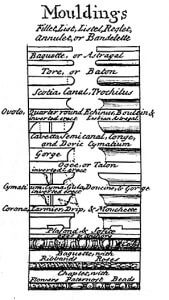Wood Stairs » Things you should know - General Info » Moulding or Molding? What is Molding?
When it comes to moulding or molding, there is not much difference in the meaning – aside from the spelling. A simple U doesn’t make too much of a difference in a word, but a slight change in spelling can indicate more about the history of that word and its origin in language.
Moulding is the “Old World” version of the spelling and molding finds itself exclusive to usage in the United States among woodworkers and carpentry businesses. Some US-based businesses or woodworking professionals might opt to go with the moulding spelling just for variety or differentiation.
What is Moulding or Molding?
The art of woodworking is as old as many ancient civilizations including believed beginnings to be in ancient Greece and ancient Rome. The definition of Moulding means a: a decorative recessed or relieved surface or b: a decorative plane or curved strip used for ornamentation or finishing, according to Merriam-Webster’s dictionary. Moulding became a popular way in countries like Canada, England and other parts of Europe to help woodworkers build aesthetically pleasing features to their homes. This is why moulding often helps to increase home values and desirability in homes in the modern day.

The practice of Moulding or Molding began as an art form with woodwork and was traditionally made with solid milled wood. However, new technologies have allowed molding to be made with PVC plastics and sometimes stone.
Fun Fact: Molding is often referred to as Coving in the United Kingdom and Australia!
There are dozens of different styles of molding including:
We can offer any custom molding profile for both residential and commercial jobs in any quantity. Please call for more information! (888) 390-7245
Mouldings in a building or home provide a variety of functions ranging from simple to functional and decorative. On the simple side, moldings do a great job of helping to hide natural joints in the framing process while building a structure.
In addition, the dozens of design combinations allow for a decorative element. These are the types of features many will add to homes to help increase property value. The benefit to using a moulding is that the concaves apply light and darkened-shaded stripes to a natural object without paint or pigment.
Lastly, mouldings are also beneficial for use as a weather-sealing joint, which adds to its form and function in a house or building. Often, mouldings are used for the benefit of all three advantages.
With the basic elements, purpose and function, along with various types and styles of moulding, they can be rearranged in thousands of combinations to help provide an efficient, but timeless and decorative look to any structure.
Sources:
Lewis, Philippa & Gillian Darley (1986) Dictionary of Ornament
Wikipedia.org
merriam-webster.com
Picture source:
Table of architecture, Cyclopaedia, 1728, volume 1
